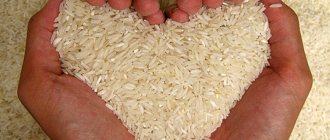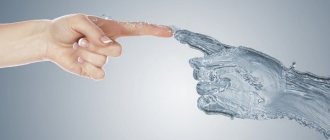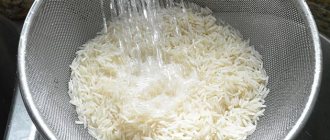If you decide to make sushi at home, then the first thing you will have to deal with is how to prepare sushi rice. Avid sushi connoisseurs will argue that rice for sushi must be of a special Japanese variety, and cooking rice in a steamer or rice cooker will make the taste of sushi as close to Japanese as possible.
But such statements could have been followed a few years ago, when preparing sushi at home was a fantasy, and to taste Japanese cuisine, you had to go to a restaurant. Now the situation is a little different, and personally, I always prepare sushi and rolls at home - it’s cheaper and I’m always confident in the quality and freshness of the ingredients used. So, before you start making sushi rolls at home, you need to know the following:
How much water do you need for 1 cup of rice?
The perfect pilaf can be prepared using the same recipe for lunch for 4 people and for a large celebration. Only the volume of ingredients increases. It can be calculated in grams or kilograms.
To cook fluffy rice you need proportions of 100 to 110 percent. In other words, 100 g of rice requires 110 g of water. A faceted glass holds 250 ml of water and 230 g of rice cereal. If you take 1 glass of rice, you will need to pour 1 glass of water, thus obtaining the required proportion.
Many people do not pay attention to what kind of water to pour into pilaf. Followers of this recipe consider it a crime to pour regular tap water.
It is necessary to use soft purified bottled water. The taste will only benefit from this.
How to cook rice in a slow cooker
Place the rice in the multicooker bowl. Add water and the spices you need. Close the lid and set the mode to “Cereals”, “Rice”, “Pilaf” or “Buckwheat”. The approximate cooking time for rice is:
- for white - 30 minutes;
- for steamed - 30–40 minutes;
- for brown - 50 minutes;
- for wild - 50–60 minutes.
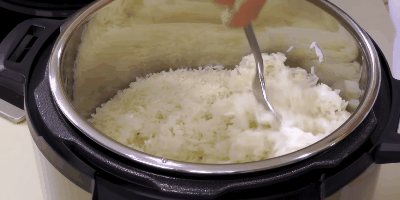
Footage: AmyLearnsToCook / YouTube
When to salt
Many have noticed that well-cooked pilaf has a sweetish taste. This is due to the sweet carrots, of which there is a fair amount in the dish, and also due to the caramelization of the onions. There is also enough sugar in onions. Excess salt in pilaf should not be felt. It is better to under-salt than to salt it several times.
Over-salting can simply “overwhelm” the bouquet of all possible flavors of meat, vegetables and spicy spices.
To keep the meat soft and the rice crumbly, the dish is salted not at the beginning or at the end of cooking, but at the stage of preparing zirvak - a sauce made from meat, vegetables and seasonings.
When you fry all the ingredients, add seasoning, pour in water, then add salt. It is important to correctly calculate the amount of salt, since the rice will absorb some of it. The approximate calculation looks like this: 1.5-2 tablespoons per kilogram of rice.
Cooking process of real fluffy rice
To make rice very crumbly, you need to choose long-shaped grains.
- Pre-soaking will help make the rice fluffy. Long varieties of rice can simply be poured with boiling water and cooled in cold liquid. Round rice is usually soaked for twenty-five minutes.
- The second secret to making fluffy rice involves pre-frying. Place the grains on a hot frying pan. Stir for a few minutes.
- In addition, many cooks use ordinary vegetable oil to prepare delicious fluffy rice. A spoonful of butter per glass of grains is enough.
Meat to Rice Ratio
If you look at it, Uzbek pilaf is a very simple food made from a minimal set of simple products. It contains meat, rice, carrots, onions, spices and water.
If you know how many ingredients, when to add, how to cook, then the treat will certainly turn out great and your guests will not be able to resist making enthusiastic comments.
Calculation of products is extremely simple: for 1 kg of meat, take 1 kg of rice and the same amount of carrots. Onions, salt and spices are added to taste.
Cutting the meat is not of fundamental importance. Usually it is cut so that it is convenient to eat later - not large, but not small either - about 5x5 cm. There are recipes when the meat is put in large pieces, so it will turn out more juicy. Slice it just before serving.
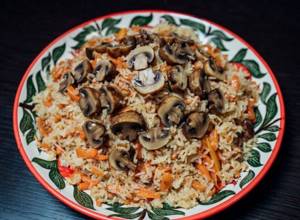
How to cook rice in the microwave
Place the rice in a microwave-safe container. It is advisable that the cereal does not take up more than ¹⁄₃ of the volume of the dishes. Add water and spices.
Cook white and steamed rice for 15–20 minutes at full power. Then stir, cover and leave in a closed, turned off microwave for 5-10 minutes.
First cook brown and wild rice on full power for 5 minutes. Then stir, set the power to medium and cook for another 20-25 minutes. Leave covered in a closed microwave for 10-15 minutes.
If the grains remain firm, continue cooking, checking every 1-2 minutes and adding water if necessary.
First carrots or onions
The tradition has survived to this day of throwing a whole onion into hot oil, boiling it in a cauldron until it becomes black coals, and then throwing it away.
Yes, onions actually adsorb harmful impurities, but in the case of refined oil, such fraud makes no sense.
The second point of using onions is that it shows the desired degree of hotness of the oil when it starts to turn black. There is no other way to determine the desired temperature.
First, chopped onions are thrown into the oil, quickly fried and the meat is added. It will be stewed in onion juice and will turn out very soft, tender and aromatic.
And only after frying the meat comes the turn to add carrots. If you put it in earlier, it will become soft and sticky, which will not improve the outcome. This is what the correct steps for adding products look like.
Oil and spices
Previously, in Uzbekistan, the homeland of pilaf, it was cooked in cottonseed oil. Cotton is the national crop of the republic. Cotton seed oil was used as food not because it was tasty and healthy. It was just cheap and accessible. In fact, the taste properties leave much to be desired.
FACT: To get rid of the unpleasant taste and neutralize impurities, the oil was properly calcined in a cauldron. This is where the tradition of bringing the oil to a “blue haze” state came from. In fact, today it is more of a culinary myth than a secret to success.
Today, in the quest for authenticity, there is no need to chase a recipe to the letter and add cottonseed oil. It's better to leave it for making soap. In pilaf it is successfully replaced by sunflower oil. Refined, odorless oil should be added. Unrefined, sunflower flavored may affect the taste. Oil balance – 0.15 – 0.2 liters per kg of rice.
Spices are divided into mandatory and optional. Only three are mandatory: salt, garlic and cumin (the second name for cumin). The rest are pepper, black and hot, paprika, turmeric, barberry, cilantro are added as desired. The quantity and composition of ingredients are determined according to taste.

You can buy a packet of ready-made pilaf seasoning mixture and use it. But if you pay attention to the composition, it will be different for different manufacturers. To prepare a real tasty pilaf, it is better to buy loose spices from the bearers of national traditions. Traders at the market will help you choose the right spices and even tell you how and when to sprinkle them correctly.
The time and method of adding spices affect how they release their aroma.
Seasonings are best added to roast (meat with vegetables). After putting them in, you need to quickly stir them, fry for 5 minutes, and then pour in water. Be sure to then boil the zirvak for half an hour. This way the spices will impart their flavor to the oil and then dissolve into the broth. It is very important that they do not burn during frying, otherwise the taste of the dish will be spoiled irrevocably.
Sushi rice dressing
For 200 grams of rice we will need the following ingredients:
- juice from one lemon (or 25 ml rice vinegar)
- 2 tbsp. vegetable oil
- 2 tbsp. water
- 2 tsp Sahara
- 1 tsp salt
Mix all dressing ingredients until dissolved. Taste the dressing - if it's too sour, add more water. When the rice has cooled, pour in the dressing and mix thoroughly with a wooden spatula so that all the dressing is evenly distributed over the rice. You will immediately see how the density and structure of the rice will change. The rice will spread very easily over the seaweed sheets.
That's all, now you know how to cook sushi rice, and how to cook sushi rice using dressing. Good luck with your culinary experiments!
Meat selection
The classic version of pilaf, which all Uzbeks cook, is made from lamb. It turns out no less tasty from other types of meat - pork and beef. Rice is also prepared with chicken and fish. You can do without meat at all - make vegetarian pilaf or make sweet pilaf with dried fruits.
The ideal recipe is one in which meat is necessarily present. It doesn't have to be lean. Dietary tenderloin, chord part, chicken breast are the least suitable parts for pilaf - when cooked it will turn out dry. It is better to choose meat with layers of fat. Ham, shoulder, neck, and brisket are ideal. The optimal ratio of lard to meat is 1 to 10. That is, 100 grams of lard per kg of clean meat.

Basic cooking rules
Knowing how much water you need per glass of rice is not the only secret to preparing this legendary dish. There are several nuances that allow you to make pilaf exactly the way it should be: moderately fatty, crumbly, with a golden hue and an incredibly rich aroma. Many housewives and professional chefs fail to achieve the desired effect. So what do you need to know to cook on a regular stove the kind of pilaf that steppe and mountain peoples make?
How much rice for 3 and 5 liters of water
For crumbly pilaf, water and rice must be carefully adjusted so as not to accidentally prepare rice porridge with meat instead of the main holiday dish. Different varieties of rice absorb water differently. The volume of water increases in proportion to the amount of rice.
At home, few people cook pilaf in large quantities. It is easier to determine the amount of rice based on the volume of the pan in which you plan to cook it.
For a small three-liter saucepan or 3-liter wok, 300 grams (1-1.25 cups) of rice is enough. For 5 liters of water – 800 grams (2.5 cups). This amount will be enough for each family member to eat well once and ask for more.
When it’s time to pour water, you need enough of it so that all the ingredients are covered with liquid by 1-2 cm.
ATTENTION: It is strictly not recommended to add water during cooking. But if, during cooking, it becomes clear that the rice does not have enough liquid, and it risks not being cooked, but remaining raw, you will have to make an exception.
You only need to pour very hot water. To do this, vertical holes are pierced in the rice from top to bottom. You can pour water into them a spoon or two at a time.
What to add to rice
You will definitely need salt. For 1 cup of grains, ¹⁄₂ teaspoon is enough. Although it is better to adjust the quantity according to your preferences.
The good thing about rice is that you can always change its taste a little. For example, using the following seasonings:
- saffron;
- curry;
- cardamom;
- cumin;
- caraway;
- cinnamon;
- carnation.
Spices are added to the water during cooking or to a ready-made dish.
Rice can also be supplemented with herbs, citrus zest, or cooked not in water, but in meat or chicken broth.
Preparing Ingredients
When preparing pilaf, remember the phrase: “Delay is like death.” Therefore, you need to prepare all the ingredients for the bookmark in advance. The cooking process will be very dynamic, so without proper experience, you can forget something important or add it at the wrong time.
One to two hours before cooking, rinse the rice well and then pour warm, lightly salted water over it. By rinsing, you rid the cereal of starchy dust, which creates viscosity during the cooking process. After this procedure, the rice does not become overcooked. Salt will help it remain firm and the pilaf will turn out crumbly.
Carrots are cut into cubes. Under no circumstances should you grate it. In this case, it boils and sticks together the grains of rice.
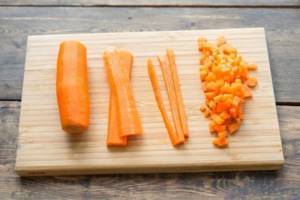
How to chop onions is not so important, since during the cooking process they practically dissolve in the dish and are needed there more for taste. Traditionally it is cut into large half rings.
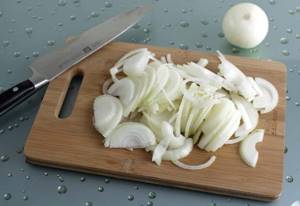
An important point: the garlic is not peeled, but whole cloves or heads are added when preparing a large portion of pilaf. The root part of the garlic is cut off - the bottom. After adding rice comes garlic. It is lightly drowned and left in the cauldron until ready, without stirring.
When served, piled pilaf is decorated with boiled garlic. Usually this kind of garlic is not eaten, but there are lovers who consider it the main delicacy.
How to cook rice in a saucepan
It is better to use dishes with a thick bottom: the temperature is distributed evenly in it.
First, bring salted water to a boil, and then pour the cereal into it. Stir the rice once to prevent the grains from sticking to the bottom. Then wait until the dish begins to boil, reduce the heat to low and cover the pan with a lid.
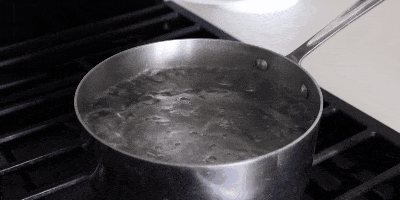
Footage: Downshiftology / YouTube
Do not lift the lid during cooking, otherwise the rice will take longer to cook. If you want the cereal to be crumbly, do not stir it (except for the first time). Otherwise, the grains will break and release starch.
The average cooking time after re-boiling, depending on the type of rice, is:
- for white - 20 minutes;
- for steamed - 30 minutes;
- for brown - 40 minutes;
- for wild - 40–60 minutes.
When the rice is cooked, remove it from the heat and let it sit covered for 10-15 minutes. If there is any water left in the finished porridge, drain it or cover the pan with a dry towel: it will absorb excess moisture.

Footage: Downshiftology / YouTube
What kind of cookware to use
It doesn't matter whether you fry in a pan or cook in a saucepan on the stove. You can cook Uzbek pilaf correctly in one or another way. The dishes should have thick walls and a bottom. A tight-fitting lid is required to prevent moisture evaporation.
It is considered unacceptable to stir the dish after adding rice. If you're cooking in a cauldron, there's really no need for stirring. The rice will steam perfectly thanks to the uniform heating of the cauldron. In a pan on gas, it is impossible to achieve the same effect as on a fire.
Nothing bad will happen if you carefully stir the rice from bottom to top with a wooden spatula towards the end of cooking. Since they will still be raw on top, while on the bottom they may begin to burn.
There are so many pilaf recipes that can be found in Uzbekistan for as many families as there are. Everyone has their own, the only correct secrets for preparing it. Pilaf can be prepared in different ways - steamed, in a slow cooker, in pots, even in dough and pumpkin.
It is important how many people will be fed with this hearty dish. If you are preparing a big holiday in nature, then you can’t think of a better dish than pilaf.
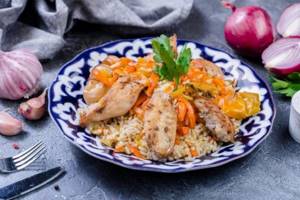
It’s a completely different matter to cook pilaf in a cauldron over a fire in the fresh air. A cauldron is a large cast iron pan with a spherical bottom. The material and shape of the cookware ensure uniform heating. The cauldron keeps the same temperature for a long time. It is optimal for cooking pilaf; it does not burn.
Uzbek pilaf
The technology for preparing Uzbek pilaf is somewhat different. For it you need to take a large amount of fat. How to cook it? Fat tail fat is melted in vegetable oil, then the onions are fried. Meat and carrots are added to it. Everything is mixed and filled with a small amount of water. This is about a glass. The mixture is simmered for some time. From this we can conclude that after adding rice you will need less liquid than for the first recipe. A glass of water will take one and a half to two glasses of water. You need to make sure that the liquid covers the rice no more than two fingers.

